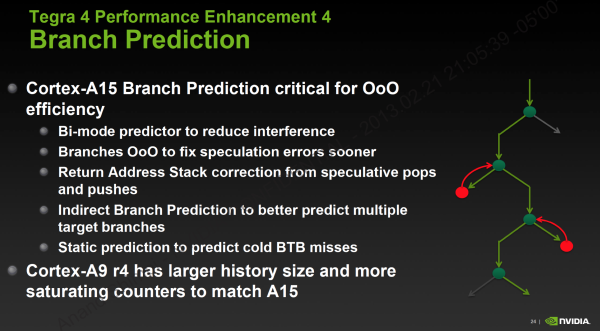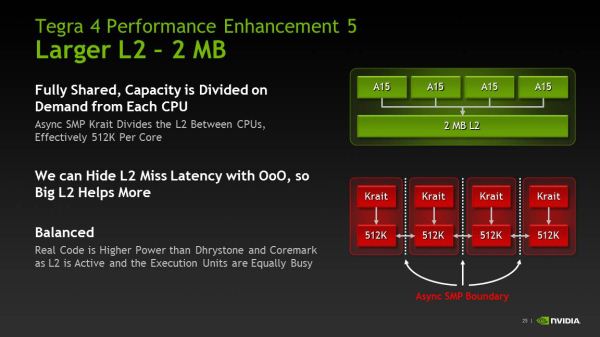NVIDIA Tegra 4 Architecture Deep Dive, Plus Tegra 4i, Icera i500 & Phoenix Hands On
by Anand Lal Shimpi & Brian Klug on February 24, 2013 3:00 PM ESTCortex A15 Architecture
I want to go deeper into ARM’s Cortex A15 but I’ll have to save that for another time. At a high level you’re looking at a much deeper, much wider architecture than the Cortex A9. The integer pipeline is significantly deeper (15 stages vs. 9 stages), however branch prediction has been improved considerably to hopefully offset the difference.
The front end is 50% wider and has double the instruction fetch bandwidth of the Cortex A9, which helps increase instruction level parallelism. In order to capitalize on the 3-wide machine, ARM dramatically increased the size of the reorder buffer and all associated data structures within the machine. While the Cortex A9 could keep around 32 - 40 decoded instructions in its reorder buffer, Cortex A15 can hold 128 - an increase of up to 4x. The larger ROB alone gives you a good idea of the magnitude of difference between the Cortex A9 and A15. While the former was a natural evolution over the Cortex A8, ARM’s Cortex A15 is really a leap forward both in performance and power consumption - clearly aimed at something much more than just smartphones.
Getting to the execution core, A15 continues the trend of being considerably wider than A9. There are more execution ports and more execution units, all of which help to increase ILP/single threaded performance. ARM went to multiple, independent issue queues in order to keep frequencies high. Each issue queue can accept up to three instructions and all issue queues can dispatch in parallel.
The A15 can execute instructions out of order like the A9, however its abilities grow quite a bit. All FP/NEON instructions had to be executed in-order on Cortex A9, but they can now be executed OoO in the A15. Despite the beefier OoO execution engine, the Cortex A15 can’t reorder all memory operations (independent loads can be executed out of order, but stores can’t be completed ahead of loads).
The Cortex A15 moves back to an integrated L2 cache structure, rather than a separate IP block as was the case with the Cortex A9. L1 and L2 cache latencies remain largely unchanged, although I do believe A15 does see a 1 - 2 cycle penalty over A9 in a few cases. The level 2 TLB and other data structures grow in size considerably in order to feed the hungrier machine.
Although the L1 caches remain the same size as NVIDIA’s Cortex A9 (32KB I + 32KB D), the the L2 cache grows to 2MB. The 2MB L2 is shared by all four cores (the companion core has its own private 512KB L2), and any individual core can occupy up to the entire 2MB space on its own. Alternatively, all four cores can evenly share and access the large L2.












75 Comments
View All Comments
darkich - Monday, February 25, 2013 - link
You should know better than to compare different platforms on sunspider.It's more software than hardware dependant benchmark.
Read the jefkibuule's post
danielfranklin - Wednesday, February 27, 2013 - link
With my own testing ive managed to get my Nexus 10 at between 500-600ms on Sunspider. Clocked at roughly 2ghz. It depends more on the browser, the stock android browser is much faster at this than Chrome and doesnt come with the Nexus 10 or Nexus 4.ilihijan - Sunday, March 3, 2013 - link
I just got paid $6784 working on my laptop using these simple steps leaked on this web page. Make up to $85 per hour doing simple tasks that are so easy to do that you won't forgive yourself if you don't check it out! Weekly payments! Here is what I've been doing Epic2.c(om)GiantPandaMan - Sunday, February 24, 2013 - link
Given the vastly different conclusions and what not, I think it would be interesting if Charlie and Anand had a roundtable discussion about the SoC space, both phone and tablet. Has Tegra had a noticeable lack of design wins? Has nVidia overpromised and underdelivered three times in a row? Or is Charlie exaggerating far too much?I'm making no judgement myself, since I really know very little about how phone and tablet manufacturers view the various SoC's.
Have you guys reached out to manufacturers and gotten their takes at all?
s44 - Sunday, February 24, 2013 - link
What, Charlie pushing anti-Nvidia storylines? Who'd have imagined that.lmcd - Sunday, February 24, 2013 - link
I feel like T2 underperformed because the software on it underperformed (see DX2), as Honeycomb was a pretty terrible release.Tegra 3 didn't do poorly at all. It performed phenomenally as a cheap chip (though the high-clocked ones on high-end phones made no sense). 28nm was a must-have for a high-end chip that generation.
Tegra 4 looks about where everyone expected it. No one should have been surprised with any of those units on the performance levels.
lmcd - Sunday, February 24, 2013 - link
DX2 and Honeycomb not being the same subject of course.But 2.3 was equally bad
rahvin - Monday, February 25, 2013 - link
A lot of what Charlie said is easily check-able. Tegra2 had a ton of design wins and almost no actual sales. Tegra3 has done phenomenally, but only in tablets and it's already been replaced in one or two. I think the most prophetic thing he said is the most obvious, unlike every previous generation they didn't announce a single design win for Tegra4. That to me speaks volumes.We'll know in time if it's just the vendetta or if his sources are correct. I've never heard of a chip maker doing a reference design and personally I just don't see that having any effect or why they would even do it. The manufacturers like to differentiate and the reference design takes that away, which again speaks to lack of manufacturer interest. Charlie tends to over exaggerate things but IMO he's been fairly spot on. Even with the highest revenue in their history profit was down almost 25% (which I attribute to the change to paying for wafer instead of good chips).
Again, time will tell.
Kidster3001 - Thursday, February 28, 2013 - link
FFRD is popular for companies that only produce the chips and not any phones themselves. Samsung has no need to do it, Apple either. Who's left? Qualcomm sells (almost) reference designs with their MDP, Intel's first two phones (Lava Xolo and Orange Santa Clara) were basically rebadged reference devices. Now NVidia's doing it. One advantage to having an FFRD is so that the customer can bring it to market faster and cheaper. OEM's like that and it also allows for chip manufacturers to get their stuff into the hands of smaller OEMs who don't have large R&D budgets.All the Tegra chips have had higher power consumption than their peers from other manufacturers. It looks like Tegra4 is no exception. They work well in tablets where it is less important, but poor battery life is a really good reason for OEM's to not make phones based on your chips.
My personal opinion is that A15 (ARMs core) will never be a really good design for a phone. It has really high performance but the power envelope just isn't going to work. Those who design custom cores will come out ahead in the phone battle: Apple, Qualcomm, Intel and perhaps even NVidia if they move away from ARM IP with their Denver design.
TheJian - Monday, February 25, 2013 - link
Charlie has hated NV forever. He did the same crap at theINQ for years. At least he named his site accurately...ROFL. Actually I enjoy reading (used to) some of his stuff, but when he speaks about NV I'd say his site should have been named usuallynotaccurate.comNow he's actually charging for semiaccurate articles...LOL
Seriously? If it was that important I'd rather pay for something like MPR. Charlie is usually good for a laugh and that's about it regarding NV.
Though I've written some stuff about this site's bias recently (my titan article posts and the 660ti article comments), I don't think anandtech and semiaccurate sit at the same table. Anandtech isn't making stuff up, they're just leaving out 3/4 of the story IMHO (regarding my comments on the 14games etc that should be in the game suite & the two that shouldn't). Charlie just throws darts at a board for a large portion of his articles. IF you keep his articles (I did for a long time) and go back over them he's only right about 50%. Either he's getting WMD like UK info (ala bush and iraq, though I think they just moved them to syria...LOL we gave them ages to move them) or he just makes it up himself ("my deep mole in x company said blah blah"). There's no proof until ages later when most forget what he even said, right or wrong. Note there is NO COMMENT section on the site now. They're all blocked :) Ubergizmo called his site "half accurate". My data of old articles used to say the same :) I expect more than flipping a coin results in reporting. He gets credit for things like breaking the news on the bapco fiasco, but I'd say Van Smith gets credit for exposing not only that Intel OWNED the land they had their building on (they paid rent to Intel), Intel OWNED their domain name, and even had a hand in WRITING the code as Intel software engineers were on hand next door. Van covered it all YEARS before Charlie. Look up Van smith and vanshardware, a lot of that crap and the biased intel reporting forced Van to leave and probably dropped the price of Toms site to 1/4 of it's value when tom dumped it. He was worth MORE than anandtech before that stuff. Not sure of the value today, I'm talking back then.
Biased reporting gets you killed if the right people keep pointing it out with DATA backing it. IF Tom's hadn't gone down that Intel love-in route he probably could have sold for much more. There's a reason Otellini said in 2006 that toms was his favorite tech site ;) Then in turn dumped the site as it's credibility tanked. Bapco was, and still is a sham. AMD/NV/VIA all left the consortium for a reason. I don't put much stock in anything from them (futuremark either). Tom's treatment of Van (even removed his bylines on stories) was downright disgusting. I stopped reading toms for about 5 years due to that crap in ~2001. He replaced every article the guy wrote with "THG staff". Total BS. Charlie does the same with NV hate as toms with Intel love. This crap costs credibility.
Anandtech is coming close to the same thing on NV gpu's; Ryan's AMD love anyway, I'll bang away until he stops :) Funny how they never attack the data I provide here. I link to them at toms forums too, eventually that will begin to hurt as people look at the evidence and draw their own conclusions about his articles and in turn this site's credibility. If he continues on the next reviews (700's and 8000's) I'll get on a lot more forums linking the comments after the data dismantling (polite critique of course Ryan :)).
The "Jian" is a double edged sword Ryan ;) Thin, light and very maneuverable...LOL
https://en.wikipedia.org/wiki/Jian
In Chinese folklore, it is known as "The Gentleman of Weapons"
I'm not hostile Ryan ;) Wikipedia says so. :)
Google this: thejian anandtech
Data piles up don't it? I save all my posts (before posting) anyway, but google does too.